Abstract
This paper deals with current issues of gender differences in approaches to learning Computer Science in Czech primary schools. The aim of our research is to propose a new curriculum for the divided learning of Computer Science for boys and girls in terms of their prerequisites for professional focus. A non-standardized questionnaire (online distribution) was used with 32 pupils (16 boys, 16 girls). The research confirmed that the current ICT environment and computer science education in primary schools are more suited to boys as boys perceive this subject more positively than girls. In this masculine environment girls have a difficult time to expressing themselves and developing their ICT skills. Despite these findings, however, girls (as well as boys) are satisfied with the content of the computer science lessons.
Keywords: GenderICTeducationCzech Republic
Introduction
Generally, the school subject of Computer Science is perceived as a subject for boys who are more likely to be dedicated to professional IT work. We consider this claim to be outdated, since ICT is used by girls as well boys, as indicated in research of Maněnová and Novotný (2017) . At the same time, we believe that the content of Computer Science has expanded to such an extent that it is advisable to reflect on the division of Computer Science for boys and girls, similarly to the subject of Work Activities, which we took as a preparation for practical occupations. Now in the modern world, however, it is more than probable that every current pupil will need to work with ICT.
Differences in the education of girls and boys
Prejudices about the specific interests of girls and boys already begin at an early age when boys receive more technical toys - cars, trains, boats, rockets, kits, scientific instruments (microscope, telescope) and tools (screwdrivers, hammers, etc.), girls receiving more dolls along with household items and clothes, baby gear (cots, strollers, trays, bottles) and household appliances (irons, ironing boards, washing machines). The relationship to technology is not innate, but unconsciously built from childhood, children adopting a traditional division of labor.
In childhood, the relationship to computers is developed through computer games or graphic editors. Research shows more boys than girls play computer games, their dominance explained by the fact that games are thematically intended for boys only. However, this explanation contradicts the objections to traditional divisions of toys.
There are many computer games now, not just demonized primitive shooters, which have become the symbol of computer games mainly for the older generation but various games that harbor significant educational and social potential can contribute to the education of children, bringing children together in joint debates and, as a result, offering a promising career. (Fialová et al., 2016)
These are the following games:
adventure games inspired by fairy tales or movies (such as a fashionable hit like Harry Potter or Lord of the Rings) where the hero must overcome a number of obstacles in action games with a similar goal
strategic games, considered to be the peak of games played in the for a long time and where the player is building virtual worlds
text games based on dialogue without graphics and animation that are demanding on logical thinking and skills
games of logic - brain teasers and puzzles simulators that mimic the management of the means of transport
RPG - Role Playing Games, where the player identifies him/herself with the main hero of the story, and even with his/her decisions can change the course of the game and influence the story (e.g. The Witcher 3). This type of game thus imaginatively becomes an exciting book that varies according to the wishes of the reader/player. In recent years, RPG games with a main heroine have increased, which of course has attracted many girls (such as Tomb Raider, Uncharted, Assassins Creed Origins and Odyssey, Last of Us, etc.).
But the question remains whether girls are playing games primarily designed for them, and how such games should actually look like so they do not copy traditional gender concepts of society again like actual toys. Since girls are often excluded from the world of computer games, boys gain a lead not only in working with computers.
It has been demonstrated that appropriately selected games improve in the ability to react quickly and make decisions. When playing children learn lessons and to change their thinking to win or improve in results, the games making children think logically and analyze a situation and search for solutions. Children who do not play games can therefore be handicapped throughout the learning process and will not form a friendly relationship with the computer. In the future, much greater fears (something they can do) and distrust (they do not know what they can expect) appear.
Of course, we must recall the expansion of language skills when playing games in a foreign language (mainly English in the Czech Republic).
A man’s world?
ICT environments are predominantly male, and therefore women may feel unnatural, which may play a role in women deciding about future careers.
Concepts about the male world are promoted by the advertising and promotional materials of computer companies, which display the profession as a highly professional and masculine one in which a woman can only take on the role of an assistant pushing buttons on printers or copiers. According to a 2005 Toshiba survey, women think that men do not want women to be involved in the industries they control. Some men prevent women from entering the field because they could cause “inflation in the field” - like the entry of men into education is conditional on higher wages, so the entry of more women could lead to lower wages in ICT. Most Czech IT specialists in the male environment feel good according to their words – men in most cases behave gallantly, without hints of sexism. (Linková, 2016)
These women, however, stress that they feel good among men as early as childhood, and that they prefer a more direct form of male communication than the unclear cues of female colleagues.
Women encountered more intense hostility from their male colleagues when women were in higher positions, which, according to stereotypical order, belonged to men. They also admitted that the workload of a woman in order to gain a higher position must be greater than that of a man. However, this phenomenon occurs in all fields, it being assumed that women in leadership positions will be harder than men. (Fialová et al., 2016)
ICT lessons in Czech primary schools
Teachers of computer technology and computer science often consider girls to be less technically capable and expect less interest in modern technology. The response of teachers is mostly that they are less dedicated to girls (“let’s keep boys with computers with Internet”), in worst cases, mocking their “skills” (“I now repeat everything for girls”), which frustrates girls. (Průcha, 2002)
ICT is generally considered to be a “writing program” or “computer repair” field. The field offers a wide application in many areas from analyzes and designs of software and system solutions playing a major role in communicating with customers, through consulting for software, hardware, and system security, to highly creative activities such as website design, multimedia games and graphic design.
These other uses of the field should also be reflected in the school curriculum and should prepare girls and boys equally for further occupation. (Kubiatko, 2013)
Problem Statement
Because of the stereotype that a man is technically gifted by nature and women are not, technically-oriented girls in the Czech Republic (as well as other western countries) do not have the opportunity to embrace their talents, because from the earliest age mostly family and school directs them to other – mostly humanistic – fields. They are afraid of failure if they choose computer science.
Most women see themselves and present themselves as technically untalented for fear of mockery because their technical skills are being questioned in advance. Women will let their male colleagues to explain their incompetence and perform the necessary tasks on the computer - unlike men who try to come up with solutions themselves and so become more competent, thus increasing their confidence in their own abilities. This study hopes to disprove this stereotype by throwing more light into this area for the benefit of girls to be adept in computer science.
Research Questions
The main research question for us is to identify and describe the gender-based perceptions of computer science among pupils of Czech primary schools.
Secondary Research Questions
Preferred activities in computer science lessons, views on the possible division of learning for boys and girls.
What do girls think about the learning of Computer Science?
Do girls enjoy Computer Science lessons? Are they satisfied with their content? Do they enjoy it more, less than or the same as boys?
What do boys think about the learning of Computer Science education?
Do boys really have different preferences than girls? Are they satisfied with the content of Computer Science lessons?
What are the opinions the division of the learning of Computer Science based on Gender?
We would like to compare whether the preferred content of computer science classes is different for girls and boys, to compare their preferences and, on the basis of these findings, address the content of computer science education.
Purpose of the Study
At the beginning of our research, we collected data and results of current
Research Methods
For our research we have chosen a generally quantitative-qualitative or mixed method design for our research. In the first phase of our research – we use a non-standardized questionnaire and its pilot research for verification of functionality of our questionnaire. In the second phase of the main part of the research – use of a non-standardized questionnaire (online distribution) supplemented by structured interviews of 4 questions with 32 pupils (16 boys, 16 girls), 2 their ICT teachers (1 man, 1 woman) and their parents as a longitudinal study (years 2016, 2017 and 2018) and a semantic differential questionnaire to identify attitudes toward ICT in primary school pupils in 2018. The data from interviews and semantic differential questionnaire are not presented in this paper as they are still in the analysis process. Only the analysis of the non-standardized questionnaire is presented here. These results show status of gender differences in ICT lessons on the Czech primary schools.
Findings
The pupils of Czech primary schools who study computer science in their curriculum were the target population of this research. Based on this premise, pupils in grades 5 to 9 in the age group from 10 to 15, or 16 years were targeted as the sample for this study. We used selection based on availability as the methodology for selecting a representative group of the population. These were 4 primary schools in two regions with approximately the same number of pupils and the same representation of girls and boys who agreed to participate in the research (a school in Hradec Králové, a school in the city with a population of 12,000 - 13,000 in the Hradec Králové region, Ústí nad Labem, a school in town with a population of 12,000 - 13,000 in the Ústí region). A total of 453 respondents in the target age of 10-15+ years participated in this study.
Overall, our questionnaire contained 25 research questions (focusing also on the relationship with ICT) and another 20 questions were part of the semantic differential.
The representation of girls and boys is graphically illustrated in Table
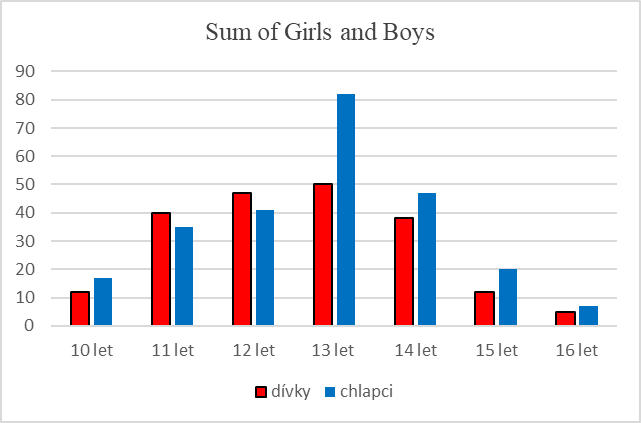
Do you enjoy the learning of computer science at the primary school?
We have chosen this question intentionally to verify the children’s relationship to the computer science lesson at the given primary school. Of course, we were aware of a large number of variables such as the personality of the teacher, the pupil’s relationship with the teacher, the pupil’s relationship to ICT, which can have influence on respondents’ answer. However, what is important for this study is the respondent’s opinion in terms of gender without taking into account other factors.
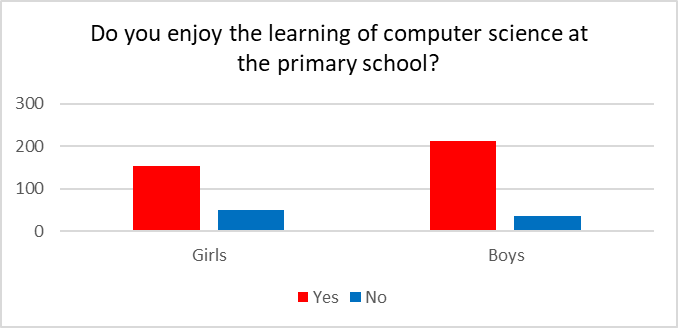
The results demonstrate that boys and girls enjoy the learning of computer science at their school.
How would you describe the Computer Science lesson at your school?
In this question respondents introduced a subjective assessment of Computer Science lessons at their school.
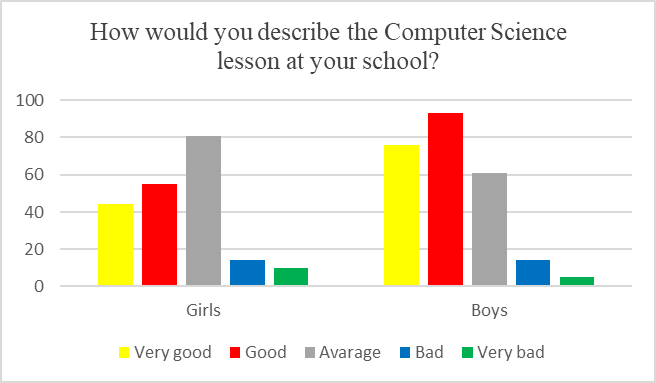
The boys evaluate the content of the lessons of Computer Science more positively than the girls. Girls evaluate the content more moderately, and more often than not, there is also a negative rating against the boys – but they are represented incomparably less than the positive ones.
Are the computer science lessons taught the way you want?
In terms of the previous question, we wanted to find out the subjective opinion the respondents had on the content of the lessons and the curriculum during the computer science lessons. They had 4 choices.
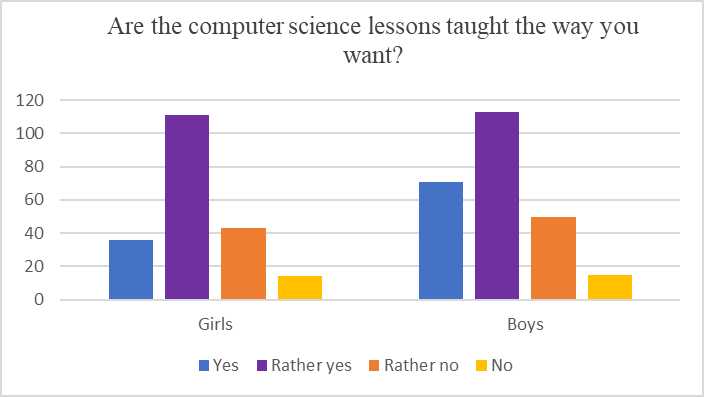
Both genders are content with the content of the computer science lessons. Boys, however, are more content than girls. The specific content of the lessons and the required changes were part of other research questions as well as a longitudinal study. Their evaluation will be included in the conclusion.
Would you like the learning of Computer Science to be gender-based?
This question deals directly with the possible future division of Computer Science lessons. Respondents were able to comment on whether they would be interested in such learning. It is necessary to bear in mind that such learning does not take place in the Czech Republic and the respondents could not even try it out in the form of projected instruction, so their expectations and ideas reflected their response.
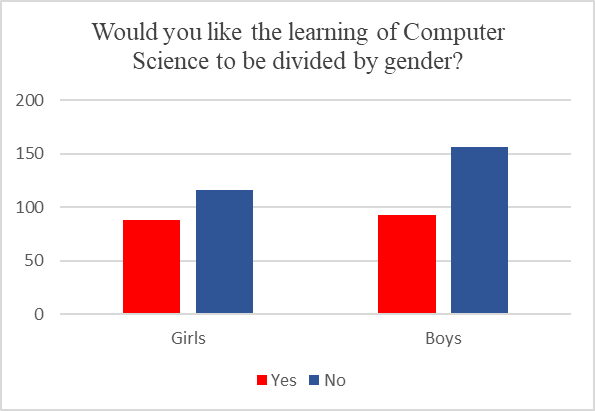
Based on the answers, we found out that girls and boys have no clear interest in the divided learning of Computer Science. Girls would accept this division more than boys. Around every third girl and every fourth boy would welcome this division, which is not a negligible representation. It would be interesting to repeat this question after a pedagogical experiment where the respondents could try out such a lesson.
I do not like answering computer and technology questions about Computer Science, because I feel embarrassed when I sometimes interrupt, or I do not understand something. Do you agree?
The last question in this paper was focused on the gender biased view that girls are afraid of expressing themselves at computer science lessons.
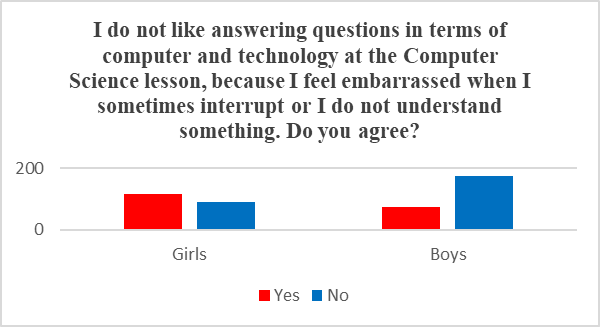
There is a clearly visible difference here, when girls are afraid/ashamed to answer questions in the field of ICT because they fear mockery in the case of a bad answer. Of course, there is a certain factor in the child’s self-awareness and education, but boys feel more self-confident in the field of ICT.
Kristova (2004) argues that current online culture has distinct masculine aspects, which can have a significant negative impact on educational reality. Negative impacts can be reflected in the passive to resistant relationship of girls to ICT, which has consequences in school – in the lack of competencies of girls for working with ICT and in subsequent educational effects in the professional focus of women. This is also evidenced by the current gender issues in the Czech Republic concerning the decline of women in science (Linková, 2016).
Conclusion
The research confirmed that the current ICT environment and computer science education in primary schools are more suited to boys; in this masculine environment girls have a difficult time to expressing themselves and developing their ICT skills.
Despite these findings, however, girls (as well as boys) who are taught the content of the computer science lessons are satisfied with their primary school. Boys perceive this subject more positively than girls.
Pupil - primary school boy and his opinion on learning Computer Science
The boys consider Computer Science as a fun and they are satisfied with the content of the Computer Science lessons. They identify more with a male teacher than a female one. During the lessons the boys are not bored and the tasks they solve in the lessons are rather easy or have average easiness.
If they could set up their own Computer Science curriculum, they would most like to devote themselves to hardware and the compilation of PC bodies, then to applications and programming. They would enjoying writing with all ten fingers or working with graphic or video editors. Most boys want to be engaged in a profession that is directly linked to ICT. Based on this, the subject of computer science is perceived as important for their future profession.
Pupil - primary school girl and her opinion on learning Computer Science
Girls have a positive relationship with the subject of Computer Science, they enjoy this subject more and are satisfied with its content. Far less compared to boys. The gender of the teacher does not play a role for them, and they increasingly notice his/her behavior toward the pupils. They consider the tasks solved in computer science are considered to be average, some difficult. Several girls are bored with computer science lessons, mostly for two reasons. Either the content is uninteresting or too difficult for them, and they do not consider it important for their future profession. Girls perceive the subject of Computer Science instead as a recreational subject than as a technical subject preparing them for their future profession. Yet girls, like boys, are aware that ICT skills will be very important to them in their professional lives.
If girls could set up their own school curriculum for Computer Science, they would like to devote themselves to ten-finger typing, effectively searching for information on the web, graphic and video editors.
Division of Computer Science and its content (innovation in the subject of Computer Science)
The future professions of current pupils will require ever more demanding and better ICT management, so it is important for primary school pupils to be educated in this area with regard to their professional qualifications and above all to be motivated to work with ICT without fear of failure, errors and lack of success in partial activities in computer science lessons.
In our research, we asked the respondent to determine what they would consider important in computer science lessons and what they would prefer to do less. Although neither girls nor boys nowadays prefer divided learning of Computer Science, they do not agree with its appropriate content in the field. As expected, boys are more technically involved in programming, hardware assembly, and more user-intensive activities; girls do not consider these activities to be important, and they much more want to improve their work with ICT, primarily ICT communication, effective search and processing of information in creative work with different editors. Most boys and girls would like less to learn about the history of ICT and important figures in the field. Both girls and boys predominate in this claim.
We believe that since teaching work activities as a subject to prepare pupils for practical professions and day-to-day activities, conducted on gender division, the teaching of computer science should also be gender-based. Modern professions, as mentioned many times, require good knowledge of working with ICT. The subject of computer science thus adopts responsibility for preparing pupils for their professional life. We do not propose the division of computer science for boys and girls because we believe that girls are less likely to handle activities such as programming and creation of applications than boys, but mainly because of the effort to create a level playing field for girls without gender stereotypes and performance comparisons to boys.
The content of these lessons would be the same for both groups, but the time allocation to individual chapters would be adjusted according to the professional prerequisites of girls and boys. By doing so, both groups would learn the same essential Computer Science, but they would especially improve in those areas that will be considered important for their future profession. We would also like to apply these aspects in the evaluation criteria of the subject of Computer Science.
We do not want to raise the question of whether this division would place the girls more in the role of ICT outsiders against boys, because boys could also complain about the fact that fewer hours of work are spent doing less cooking than girls and no embroidering at all, while girls do not try welding. This division of learning would not prevent girls from being a programmer, IT managers, but on the contrary, they should give them the motivation to improve themselves in a friendly environment of girls without the mockery and stereotypes that persist in our society and the rearing of children, although they are totally unsubstantiated in the 21st century.
Acknowledgments
This article was written with the support of the University of Hradec Králové.
References
- Brdička, B. (2004). Vliv technologií na inovaci výukových metod. Česká škola [online]. [cit. 2018-07-05]. Retrieved from http://www.ceskaskola.cz/ICTveskole/Ar.asp?ARI=101958&CAI=2129
- Dijkstra, E. W. (1989): On the Cruelty of Really Teaching Computing Science, Communications of the ACM, 32, S. 1398-140
- Fialová, I., & Pavlíček, J. (2016). Gender a ICT ve škole. Praha, 2010. Retrieved from: http://www.spomocnik.cz/pub/Gender_Fi_Pa.pdf
- Janík, T., Knecht, P., & Šebestová, S. (2011). Smíšený design v pedagogickém výzkumu: Sborník anotací příspěvků z 19. výroční konference České asociace pedagogického výzkumu. 1. vyd. Brno: Masarykova univerzita.
- Kubiatko, M. (2013) The Comparison of Different Age Groups on the Attitudes toward and the Use of ICT. Educational Sciences: Theory & Practice, Turkey.
- Kristová, M. (2004) Ženy a ICT. In Kontext: časopis pro gender a vědu, č. 3-4. Retrieved from http: //genderaveda.cz
- Linková, M. (2016). O postavení žen ve vědě. In Kontext: NKC Gender and science (audio), ČRo Plus. Retrieved from https://soundcloud.com/nkc-gender-and-science/marcela-linkova-a-arnost-marks-o-postaveni-zen-ve-ved-25516
- Maněnová, M. (2009) Učitel primárního vzdělávání ve vztahu k ICT: (výzkum současného stavu). 1. vyd. Hradec Králové: Gaudeamus.
- Pelgrum, W. J., Law, N. & Plomp, T. (Eds.) (2008). Pedagogy and ICT in schools around the world: findings from the SITES 2006 study. Hong Kong: CERC and Springer.
- Sak, P., & Mareš, J. (2007). Člověk a vzdělání v informační společnosti. Vzdělání a život v komputerizovaném světě. 1. vyd. Praha: Portal. 290 s.
- Preuschoff, G. (2007) Výchova dívek. Praha: Portal.
- Rechenberg, P. (1997): Quo vadis Informatik? LogIn 17(1), S. 25-32.
- Smetáčková, I. (Ed.) (2006). Gender ve škole. Příručka pro budoucí i současné učitelky a učitele. Otevřená společnost.
- Wastiau, P., Blamire, R., Kearney, C., Quittre, V., Van De Gaer, E., & Monseur, C. (2013). The Use of ICT in Education: A Survey of Schools in Europe. European Journal of Education. 48(1), 11-27.
- Zounek, J. (2006). ICT v životě základních škol. 1. vyd. Praha: TRITON.
Copyright information

This work is licensed under a Creative Commons Attribution-NonCommercial-NoDerivatives 4.0 International License.
About this article
Publication Date
14 January 2019
Article Doi
eBook ISBN
978-1-80296-052-5
Publisher
Future Academy
Volume
53
Print ISBN (optional)
-
Edition Number
1st Edition
Pages
1-812
Subjects
Education, educational psychology, counselling psychology
Cite this article as:
Novotný, R., & Maněnová, M. (2019). Gender Differences in Attitudes to ICT Lessons in Czech Primary Schools. In Z. Bekirogullari, M. Y. Minas, & R. X. Thambusamy (Eds.), ICEEPSY 2018: Education and Educational Psychology, vol 53. European Proceedings of Social and Behavioural Sciences (pp. 524-534). Future Academy. https://doi.org/10.15405/epsbs.2019.01.50

